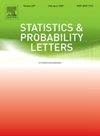The eschewed sinh-arcsinh t distribution
IF 0.7
4区 数学
Q3 STATISTICS & PROBABILITY
引用次数: 0
Abstract
Rosco et al. (2011) introduced and studied the sinh-arcsinh (SAS-) distribution. In this article, we introduce a modified version of that distribution which we call the eschewed sinh-arcsinh (ESAS-) distribution. The new proposal proves to be somewhat simpler than the former and, on balance, given the pros and cons listed in the article, we now recommend the ESAS- distribution over the SAS- distribution as the preferable version of a sinh-arcsinh distribution.
避开了sinh-arcsinh - t分布
Rosco et al.(2011)介绍并研究了sinh-arcsinh t (SAS-t)分布。在本文中,我们将介绍该分布的一个修改版本,我们将其称为回避的sinh-arcsinh t (esa -t)分布。事实证明,新提案比前一个提案要简单一些,总的来说,考虑到本文中列出的优点和缺点,我们现在推荐ESAS-t发行版,而不是SAS-t发行版,作为sinh-arcsinh -t发行版的首选版本。
本文章由计算机程序翻译,如有差异,请以英文原文为准。
求助全文
约1分钟内获得全文
求助全文
来源期刊

Statistics & Probability Letters
数学-统计学与概率论
CiteScore
1.60
自引率
0.00%
发文量
173
审稿时长
6 months
期刊介绍:
Statistics & Probability Letters adopts a novel and highly innovative approach to the publication of research findings in statistics and probability. It features concise articles, rapid publication and broad coverage of the statistics and probability literature.
Statistics & Probability Letters is a refereed journal. Articles will be limited to six journal pages (13 double-space typed pages) including references and figures. Apart from the six-page limitation, originality, quality and clarity will be the criteria for choosing the material to be published in Statistics & Probability Letters. Every attempt will be made to provide the first review of a submitted manuscript within three months of submission.
The proliferation of literature and long publication delays have made it difficult for researchers and practitioners to keep up with new developments outside of, or even within, their specialization. The aim of Statistics & Probability Letters is to help to alleviate this problem. Concise communications (letters) allow readers to quickly and easily digest large amounts of material and to stay up-to-date with developments in all areas of statistics and probability.
The mainstream of Letters will focus on new statistical methods, theoretical results, and innovative applications of statistics and probability to other scientific disciplines. Key results and central ideas must be presented in a clear and concise manner. These results may be part of a larger study that the author will submit at a later time as a full length paper to SPL or to another journal. Theory and methodology may be published with proofs omitted, or only sketched, but only if sufficient support material is provided so that the findings can be verified. Empirical and computational results that are of significant value will be published.
 求助内容:
求助内容: 应助结果提醒方式:
应助结果提醒方式:


